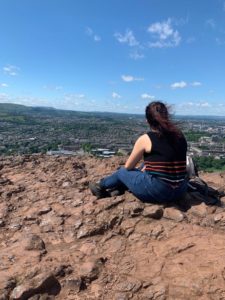Zein Al-Maha Oweis is a Jordanian PhD student at the University of Glasgow studying Media and Cultural Policy. She is visually impaired and uses a white cane. When not focusing on her research she can be found with her nose in a novel at the Botanical Gardens, out with friends or can be found dancing Bachata on the dance floor. In part one of her blog on travelling with a visual impairment, she shares some of the lessons she has learnt whilst adventuring around Scotland.
As the first year of my PhD ended and summer began, the itch to travel after many lockdowns and restrictions grew. I decided to take advantage of being in one of the most beautiful, historic countries in the world. Even though I was excited to travel and seek new adventures, my mind was occupied by questions of how accessible the places I wanted to visit would be and whether I would be able to walk around with my trusty white cane “Bonnie”. While working on my travel plans, I learnt some useful lessons that I hope might help others with disabilities while on their travels.

Picture description: Zein standing outside the University of Glasgow. She has her arms spread wide and is holding her white cane “Bonnie”.
Alright Google, where to next?
Before travelling around Scotland, I decided to do some research on must-see places that are close to Glasgow. Sure enough, my research linked me to places such as Edinburgh, Stirling, Loch Ness and other smaller places such as Fife, St. Andrews, Falls of Falloch and Pitlochry.
I began looking into different routes to take that would be accessible but, also would give me the opportunity to visit while staying safe. Me being the avid researcher that I am, I would research every place I wanted to visit and whether they were accessible for me to use my cane. This included researching any tour aids that were being offered at the castles, museums, and other historical sites I was planning to visit.
Alongside this, I researched whether these places could be reached by train, bus or ferry in order to inform the right personnel that I am a person travelling with a disability. I did this when I took a tour to the Highlands with Lindsey Highland Tours with my friends during July when my mother visited from Jordan. I made sure to inform them of my visual impairment, as I always do when on tours, in order for the tour guide to be aware in case we were visiting any dim-lit areas so that they could assist me if needed. This came in handy when we visited Urquhart Castle near Loch Ness. Some areas inside the castle had stairs that were the same colour as the brown castle walls. My friends and the tour guide helped me locate the first step as well as the railing at the top of the stairs by giving voice commands such as “Zee we are coming to a step” or “Zee would you like to hold on to my arm or the railing?”
Finally, I would research if any documentation was needed to keep with me in case of emergencies. I always have a copy of my latest ophthalmology letter just in case I am asked about my visual impairment. One piece of advice I would give is to research anything you need to know before travelling so that you don’t end up being put in an uncomfortable situation.

Picture description: Urquhart Castle. Loch Ness is visible behind the ruins of the castle.
Never be afraid to ask for help
Brittany Burgunder said, “Needing help does not have a look, but asking for it always looks beautiful” which, is true. Sometimes we are afraid of asking for help because we do not want to admit that we need it but, if I did not ask for help every time I needed it then I would not have been able to see some of Scotland’s most beautiful places.
Being visually impaired means that I need help with mobility in order to get around. Sure, I am independent and walk with a cane but, I still need help with moving through crowds and going up and down stairs. This came in handy when climbing up to Arthur’s Seat in Edinburgh. Going up was the easy part, coming down was the challenge. If you have been to Arthur’s Seat you will know how difficult it can be to walk up as the nature around presents obstacles as the walkway is made of dirt, stones, and uneven steps. It was hard to use my cane but, I did the climb in two hours thanks to the help of one of my friends who knew when and how to offer the help I needed. For starters, she let me hold onto her arm (which is a technique we are trained to use during Mobility and Orientation training doing cane work) when crossing uneven areas such as at the top of Arthur’s Seat.
Second, she knew that I would not be able to use my cane when descending so she suggested I sit on the ground and use my touch senses to feel my way down which was beneficial (although I could not say that it was beneficial to the colour of my jeans!). Finally, my friend knew that the only way to descend was to give her my cane, hold onto her hand and trust her with helping me get back down to even grounds! It was the first time in a while that I had to trust someone’s help without using my cane. The last time I did that was when I was around family before the lockdowns began. I never go anywhere without my cane but, here I was put in a situation where I had to trust someone to help me hike down 251 meters just by holding onto her forearm. I took a leap of faith and in the end, it worked out but, if I did not rely on her help I would not have even reached the top and would not have been able to enjoy the panoramic view of Edinburgh. It shows you that with the right kind of help you can do anything even with a visual impairment.

Picture description: Zein at the top of Arthur’s Seat. She is sitting with her back to the camera looking out over the view of Edinburgh.
Stay tuned for part two of Zein’s blog, where she’ll be sharing more tips from her experience of travelling with a visual impairment.
Posted on the: October 14, 2021



 0141 332 4632
0141 332 4632


